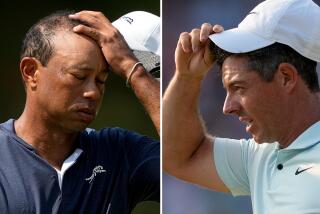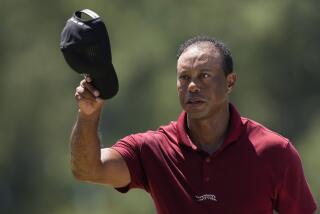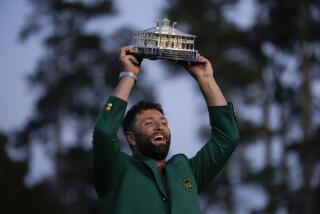Mental Plan
- Share via
Not long before he began the final round of his demolition of the PGA Championship and Luke Donald, Tiger Woods stuck two tees into the manicured grass of the putting green at Medinah Country Club.
The tees were about five inches apart, the gap slightly wider than the blade of his putter. Woods placed a ball just in front. He put his left hand on his thigh and swung the club, using only his right hand, the drill designed to make sure he draws the putter back square.
Woods has used this practice technique for years, since his father, Earl, came up with the idea.
Usually, Woods keeps going until he makes 100 putts in a row from a distance of four feet. Then he’s ready.
Anyone who could get close enough leaned against the ropes that ringed the putting green. It was an almost methodical, unemotional scene, serene almost to the point of being eerie, a warmup routine from which he rarely varies.
And once Woods walked to the first tee, shook hands with playing partner Donald and smashed a five-wood that deposited the ball in the middle of the first fairway, there was also nothing unusual about the rest of the day either.
Surrounded by more than 40,000 fans, deafening noise and suffocating pressure, Woods was an island apart. He shot a four-under-par 68, his fourth consecutive round in the 60s, and won his 12th major championship, this time by five shots. The result was not unexpected.
Donald, tied for the lead after three rounds, faded with a two-over 74. Once again, the player matched with Woods in the last round of a major had come up short, and that wasn’t unusual either.
Drawing Tiger in the final round of a major is the closest thing to a kiss of death. Woods hasn’t lost a major title when he began the fourth round in the lead or tied -- he is 12-0 -- and the manner in which he brushed aside Donald, and every other challenger at Medinah, has become routine.
Woods has a stock answer whenever he is asked what his greatest quality is. He always says mental toughness, and he mentioned it again to reporters Wednesday at the Bridgestone Invitational at Akron, Ohio.
“I think that your mind will carry you,” he said. “The mind controls the body. So if the mind tells the body what to do, it’ll do it. It’s just a matter of getting the mind under control to make your body respond.
“And under the most extreme circumstances, when the competition is that fierce and that heightened and my concentration is that high, I feel like I can make things happen.
“Over the course of my golf career, I’ve had it happen enough times where I can always say to myself, ‘I’ve done this, I’ve done it before.’ That gives you confidence.”
Number crunching in these high-pressure, final-day, major situations could take all day, but it always turns out this way: 69.2 fourth-round scoring average for Woods, 72.9 for his playing partners.
Donald was only the latest to get run over by Woods.
“He has a great mental belief in himself,” Donald said. “He’s obviously got a good game, but he just kind of wills it in the hole.”
Donald is a rising star on the PGA Tour, and considered one of the stars of the European Ryder Cup team, but there is another noteworthy team he joined Sunday at Medinah ... those who have been steamrollered by Woods, and left to talk about it.
Chris DiMarco was paired with Woods in the last round of the 2005 Masters and wound up losing in a playoff, so he feels for what Donald went through, which is basically enough suffocating pressure to suck the air from your lungs.
“You would think going to the first tee that he would feel the pressure because everybody is expecting him to win, and it’s the exact opposite,” said DiMarco, who outshot Woods, 68-71, in that final round. “The guy playing him feels the most pressure. The fact that you have to go face to face with Tiger, he’s a pretty intimidating guy, no doubt about it.
“I’ve never seen anybody, take away Jack Nicklaus, he’s the only other guy, I’ve ever seen who looks more comfortable leading on the back nine of a major than playing the first hole of a tournament, and that’s pretty scary.
“It’s unbelievable that he can feel that comfortable. I mean, it’s almost like he comes into his comfort zone in that situation and just relishes the fact that everybody for the most part wants to see him trip. Players are, like, ‘Please make bogeys, other people make birdies’ and he just puts the hammer down.
“At the end, he wins by four or five and your hat’s off to him. He’s the best.”
The experience is educational, if not painful. Sergio Garcia, who has played with Woods in the final pairing at the 2002 U.S. Open and last month’s British Open -- and lost both times -- said you might as well laugh about it, because crying simply won’t help. Someone, someday might beat Woods ... or maybe not, Garcia said.
“It doesn’t look like it,” he said. “What can I say? It will happen eventually. I mean, he’s not going to be 68 years old and in the final round of a major and tied for the lead and he wins. We’ll see then.”
The Masters, the U.S. Open, the British Open and the PGA Championship are professional golf’s defining moments, the grandest stages, and winning them defines careers. They are demanding and severe and often punishing, and Woods seems to have come up with a way to handle it better than anyone.
Sometimes it isn’t even about golf. Woods is completely at ease making his opponents uncomfortable. He says little, stares ahead during play, or looks down. Even his conversation with his caddie, Steve Williams, is limited. Woods rarely speaks to the other player in his pairing, so no one should have been surprised that after he shook hands with Donald at the first tee, that was the limit of their interaction.
Woods did notice that Donald had chosen a red shirt, the color that Woods famously saves for his Sundays on the field of competition. If it was intended as a question of Woods’ authority, it backfired on Donald.
Woods’ reaction: “I didn’t think anything of it.”
Besides a stone-cold stare on Sundays, Woods is known for acquiring a psychological edge, regardless of its inspiration. He is like the high school football coach who clips newspaper stories on the other team that can be used as motivation, and he pins them to his mental bulletin board.
That’s what Woods did when Vijay Singh’s caddie once wore a “Tiger Who?” cap at a Presidents Cup match, where Woods trounced Singh.
He surely noticed when Dave Pelz, the coach of rival Phil Mickelson, said last week that his player was the best in the world when going right. When told of Pelz’s comments, Woods smiled and said: “I think I’m pretty tough to beat when I’m playing well too.” In the last two majors, the British Open and the PGA Championship, Woods has beaten Mickelson by a combined 25 shots.
Woods is a crowd magnet, especially at a major, and even more so if he’s in contention on Sunday. Fans clog the areas of the course where Woods is in action, watching him play a certain hole, or moving ahead to the next to be ready when he passes by. For the players ahead of Woods or behind him, it’s often unnerving to have fans moving during play.
J.J. Henry, who was one group ahead of the Woods-Mickelson-Geoff Ogilvy pairing the first two days of the PGA, took stock of the commotion.
“It seemed like 40,000 were on about two holes -- the hole in front of them and the hole they were on,” Henry said.
Woods’ preparation for such a scene of chaos begins quietly enough when he arrives at the course, typically about an hour and 15 minutes before the final round. He starts with his putting drill with the two tees and when he shifts to the driving range, he spends 30 to 40 minutes, beginning with a sand wedge and moving from the higher-lofted clubs to the lower-lofted clubs in his bag. Then he returns to the putting green for a final warmup before going to the first tee.
It is Williams’ duty to bring a copy of the pin sheets to Woods at the driving range, showing the precise location of the pins on each green. Woods studies them, then practices as if he is hitting toward each pin, allowing him to decide what kind of shots to hit to every green while he’s still on the range. This preparation method is unique to Woods.
His last shot on the driving range is the first shot he’ll hit at the first tee. On Sunday, he rocketed a five-wood at the range, duplicated the shot at the first tee and was off and running.
Whatever his method, it has proved unbeatable in majors. Woods’ record is 37-3 in all tournaments when he’s tied for the lead or in the lead after 54 holes. He also is 9-1 in playoffs, his only loss to Billy Mayfair in the 1998 Nissan Open at Valencia Country Club.
“It’s a neat thing when they bring it up, on TV or the papers, but I kind of laugh about it,” Mayfair said. “I’ve only won one time since and Tiger has won, what, 50 or 60? So I guess I’m the answer to a trivia question.”
Woods’ victory last week at Medinah was his third straight, and this week, he is at the Bridgestone Invitational, an event he has won four times. The last player to win as many as four consecutive tournaments was Woods, when he won six straight in 1999-2000.
This is Woods’ seventh year with at least five victories or more. The only player ahead of him is Sam Snead, who had eight years with at least five victories.
Woods’ winning streak was built in three ways. He won the British Open leading the field in driving accuracy, won the Buick Open by leading the field in driving distance and won the PGA by leading in greens in regulation.
His confidence seems to be growing, which can’t be good news to his peers. Before winning at Royal Liverpool, Woods told Hank Haney, his coach, that his goal was to “run the table” the rest of the year, to win every tournament he played.
Haney said it would be wise not to dismiss Woods, that after Earl Woods died in May, Woods grieved, and then pushed himself even deeper into his golf business.
“He learned so much from his dad, it was a difficult time and he’s handling it better each day,” Haney said. “He’s showed it the last two majors.
“But there’s no part of his game that can’t improve. His biggest problem has been his putting, but he had a great putting tournament at Medinah. His attitude is to just try to get better. He’s not going on any cruise control, I can tell you that.”
After the British Open, Ernie Els said he was as impressed as ever by Woods with his 18-under winning score. Els should know. He’s on the victims list too, paired with Woods in the final round of the 2000 U.S. Open at Pebble Beach, where Woods won by 15 shots.
“You know, he knows how to win these things. It’s going to be tough to beat him now.”
So far, it has been impossible.
*
Begin text of infobox
Final answer
What Tiger Woods and his playing partner have shot in the final round of Woods’ 12 major championships and the result:
*--* YEAR, EVENT PAIRING RESULT 1997 MASTERS Woods 69, Costantino Rocca 75 Woods beats Tom Kite by 12 1999 PGA Woods 72, Mike Weir 80 Woods beats Sergio Garcia by one 2000 U.S. OPEN Woods 67, Ernie Els 72 Woods beats Els and Miguel Angel Jimenez by 15 2000 BRITISH OPEN Woods 69, David Duval 75 Woods beat Thomas Bjorn by eight 2000 PGA Woods 67, Bob May 66 Woods wins in three-hole playoff 2001 MASTERS Woods 68, Phil Mickelson 70 Woods beats David Duval by two 2002 MASTERS Woods 71, Retief Goosen 74 Woods wins by three 2002 U.S. OPEN Woods 72, Sergio Garcia 74 Woods beats Phil Mickelson by three 2005 MASTERS Woods 71, Chris DiMarco 68 Woods wins in sudden-death playoff 2005 BRITISH OPEN Woods 70, Jose Maria Olazabal 74 Woods beats Colin Montgomerie by five 2006 BRITISH OPEN Woods 67, Sergio Garcia 73 Woods beats Chris DiMarco by two 2006 PGA Woods 68, Luke Donald 74 Woods beats Shaun Micheel by five
*--*
*
Los Angeles Times
More to Read
Go beyond the scoreboard
Get the latest on L.A.'s teams in the daily Sports Report newsletter.
You may occasionally receive promotional content from the Los Angeles Times.










